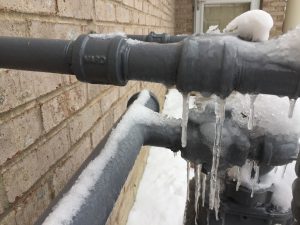Avoiding Pipes from Freezing: Best Tips
Avoiding Pipes from Freezing: Best Tips
Blog Article
On this page in the next paragraphs you can discover some superb insight concerning 6 Ways to Prevent Frozen Pipes.

Winter can damage your plumbing, especially by freezing pipelines. Below's how to stop it from happening and what to do if it does.
Introduction
As temperature levels drop, the risk of frozen pipes increases, potentially bring about costly repair work and water damage. Comprehending how to prevent icy pipes is critical for home owners in cool climates.
Understanding Frozen Pipelines
What causes pipes to ice up?
Pipes freeze when exposed to temperature levels below 32 ° F (0 ° C) for extended periods. As water inside the pipelines freezes, it broadens, putting pressure on the pipeline walls and potentially triggering them to break.
Threats and problems
Frozen pipelines can lead to supply of water interruptions, property damages, and expensive fixings. Ruptured pipelines can flood homes and cause comprehensive architectural damage.
Indications of Frozen Pipes
Identifying icy pipes early can stop them from bursting.
Just how to determine icy pipes
Seek lowered water flow from taps, uncommon smells or sounds from pipelines, and noticeable frost on subjected pipes.
Avoidance Tips
Insulating vulnerable pipes
Cover pipes in insulation sleeves or utilize warmth tape to protect them from freezing temperatures. Focus on pipes in unheated or outside locations of the home.
Heating methods
Keep indoor areas effectively heated, particularly areas with pipes. Open cabinet doors to allow warm air to distribute around pipelines under sinks.
Shielding Outside Pipes
Yard tubes and outdoor faucets
Separate and drain yard hoses prior to wintertime. Set up frost-proof spigots or cover outside faucets with shielded caps.
What to Do If Your Pipes Freeze
Immediate actions to take
If you believe frozen pipelines, maintain taps open up to eliminate stress as the ice melts. Use a hairdryer or towels soaked in hot water to thaw pipelines gradually.
Long-Term Solutions
Architectural adjustments
Take into consideration rerouting pipes far from exterior wall surfaces or unheated areas. Include added insulation to attic rooms, cellars, and crawl spaces.
Updating insulation
Buy high-quality insulation for pipelines, attic rooms, and wall surfaces. Appropriate insulation aids maintain constant temperature levels and reduces the threat of frozen pipes.
Final thought
Stopping icy pipelines calls for proactive actions and quick responses. By understanding the reasons, signs, and safety nets, homeowners can safeguard their pipes throughout cold weather.
6 Proven Ways to Prevent Frozen Pipes and Protect Your Home
Disconnect and Drain Garden Hoses
Before winter arrives, start by disconnecting your garden hoses and draining any remaining water. Close the shut-off valves that supply outdoor hose bibs and leave the outdoor faucet open to allow any residual water to drain. For extra protection, consider using faucet covers throughout the colder months. It’s also important to drain water from any sprinkler supply lines following the manufacturer’s directions.
Insulate Exposed Pipes
Insulating your pipes is an effective way to prevent freezing. Pipe insulation is readily available at home improvement stores and is relatively inexpensive. Pay close attention to pipes in unheated areas such as the attic, basement, crawl spaces, or garage. Apply foam insulation generously to create a buffer against the cold. You can also wrap your pipes in heat tape or thermostat-controlled heat cables for added warmth.
Seal Air Leaks
Inspect your home for any cracks or openings that could let in cold air. Seal any holes around the piping in interior or exterior walls, as well as the sill plates where your home rests on its foundation. Additionally, make sure to keep your garage door closed unless you’re entering or exiting. Leaving it open creates a significant air leak that can lead to frozen pipes.
Allow Warm Air Circulation
During cold snaps, it’s essential to allow warm air to circulate evenly throughout your home. Leave interior doors ajar to promote better airflow. Open kitchen and bathroom cabinets to help distribute heat consistently around the rooms. If you have small children or pets, be sure to remove any household chemicals or potentially harmful cleaners from open cabinets for safety.
Let Faucets Drip
A small trickle of water can make a big difference in preventing ice formation inside your pipes. When temperatures drop significantly, start a drip of water from all faucets served by exposed pipes. This continuous flow helps prevent the water from freezing. Additionally, running a few faucets slightly can relieve pressure inside the pipes, reducing the chances of a rupture if the water inside does freeze.
https://choateshvac.com/6-proven-ways-to-prevent-frozen-pipes-and-protect-your-home/

We hope you liked our post about How To Avoid Freezing Pipes. Many thanks for taking a few minutes to read through our short article. Are you aware of another individual who is in to the topic? Do not hesitate to share it. Kudos for your time. Kindly visit our site back soon.
Here Report this page